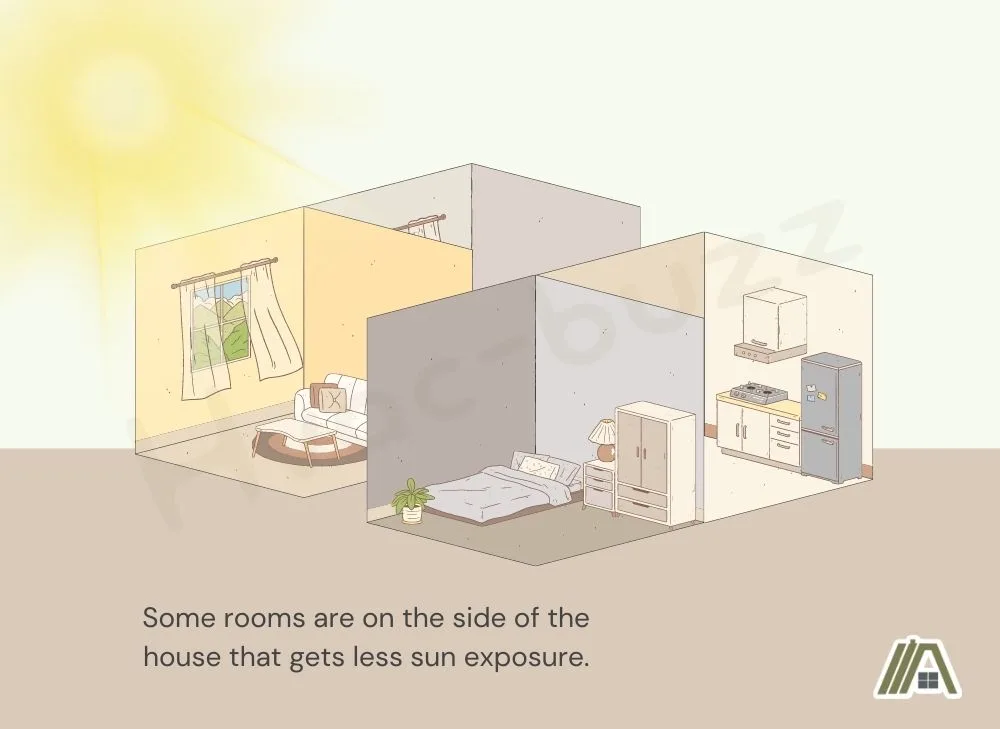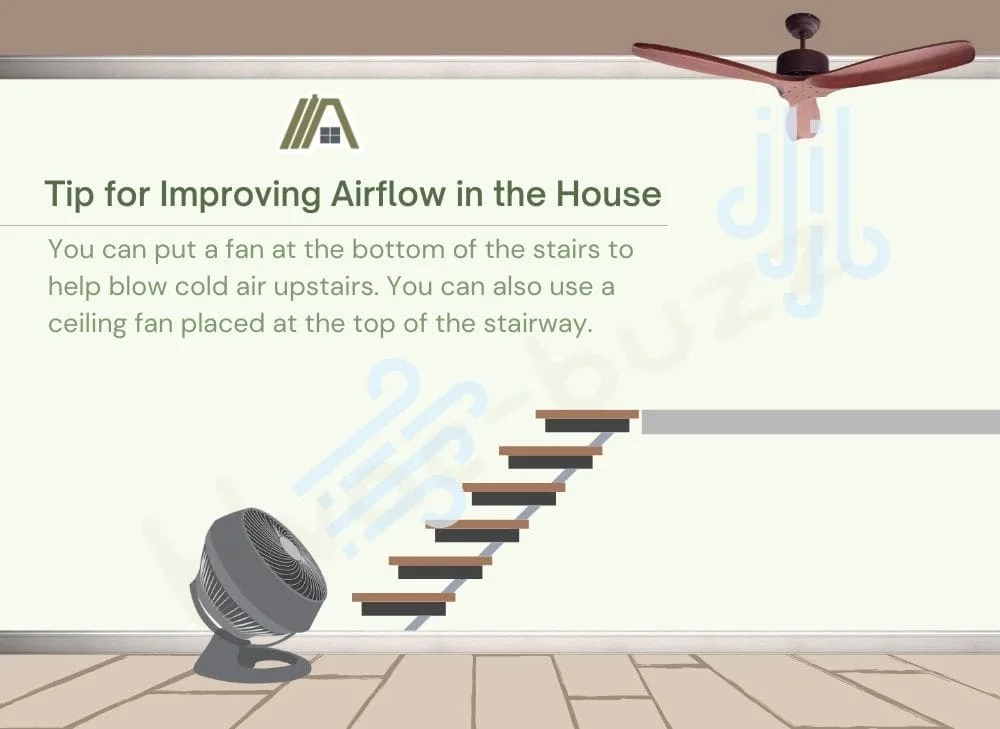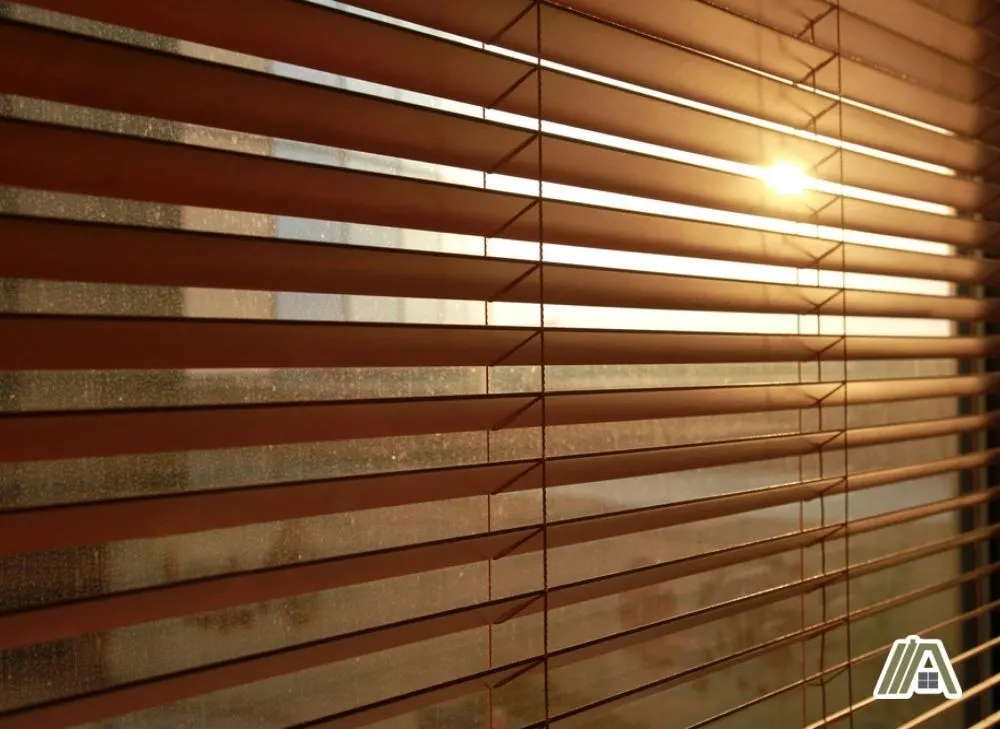A common problem for house owners seems to be that one room always stays cold while another one is the polar opposite: always too hot. If only they would share their temperatures and even out! It would be easier than installing an air conditioning unit or bringing in a heater.
Thankfully, typical ventilation methods seem to be the solution to this kind of problem. Depending on which way suits your situation best, you just need a few well-thought-out windows and doors open and a fan.

Getting cold air to another room requires ventilation to move the air. This can be natural or mechanical ventilation or a combination of both. Cross breezes, the chimney effect, room-to-room transfer fans, fans in the cold or warm room, and whole-house fans will move cold air around.
Why Is One Room Colder Than the Other
There are a few different reasons why one room may be colder than another:
- Some rooms are on the side of the house that gets less sun exposure. Along with being darker, these are often cooler because the heat of sun rays is not influencing them. For example, my brother had a south-facing room growing up, and while it was lovely and cool in the summer, it was also freezing in winter.

- If an AC unit is installed in the room, it is being fed with cold air and will have a lower temperature than the rooms around it.
- The natural separation of warm and cool air can also result in lower rooms being colder than upper floors as cold air sinks and warm air rises. This is especially true for basements, and many people seek to move cold air out and up from this lowest point.
How to Move Cold Air to a Different Room
Hot and cold air naturally separate because hot air has more energy and moves and expands, which makes it lighter. Cold air has less energy, so it is denser and will sink while hot air rises.
The key to getting cold air to replace hot air is to remove warm air at a high point. Firstly, this removes the hot air. Secondly, it creates a vacuum-like effect that draws cold air into the space vacated by the hot air.
Another trick is to simply force cold air into a room using mechanical force. This should displace hot air to make room for the new air being forced inside.
Use a Room to Room Transfer Fan
You can install a room-to-room transfer fan like the Tjernlund Aireshare (amazon link) or even the AC Infinity AXIAL Muffin Fan (amazon link). If the two rooms have a connecting wall, this is the easiest and most effective way to move air between the rooms. It is also a very affordable solution.
It has an intake side and an output side. The nice thing about using this fan is that you don’t need to leave doors or windows open for it to work, so you still maintain a sealed building envelope. This keeps HVAC costs down as you don’t lose conditioned air to the outdoors.
This can also add to your privacy. By removing the need to leave an entrance open between the rooms, you can close the door without interfering with the airflow between the rooms.
Create Natural Airflow
It is easy enough to create natural airflow in your house by opening doors and windows in different rooms.
If you are specifically trying to move cool air through the house, you want to open windows at the highest point of the house and lowest points while closing all other openings.
This allows the air to naturally filter out the house, with warm air leaving from the higher points, which then pulls colder air up from the lower points (chimney effect). By keeping the air flowing, you are helping to prevent hot air and cold air from settling at different levels.
Alternatively, especially in single-story houses, you can open windows on opposite sides of the house to create a cross breeze. This will also help to circulate air through the house.
Tip for Improving Airflow in the House
You can help out the natural airflow by putting a fan in strategic places and running ceiling fans:
- Put a box fan at the upper windows. Then, aim the fan out the open windows where the hot air will be leaving, which aids in pushing the air out.
- You can also put a fan at the bottom of the stairs to help blow cold air upstairs. You can also use a ceiling fan placed at the top of the stairway.

- Running your ceiling fan helps to circulate air in both winter and summer. The winter mode helps move air down from the ceiling, while the summer mode pushes air down from the blades. You can use the different modes according to what each room requires.
- Exhaust fans can also help. For example, range hoods and bathroom exhaust fans remove air and encourage makeup air to filter into the room.
Ensure your registers and vents are open as well! There is a common misconception that you can make your HVAC system more efficient or you can redirect cold air by closing vents, but it actually makes your system work harder.
Run a Box Fan in the Warm Room
You can set up a box fan, like the Genesis 20” Box Fan (amazon link), to help push hot air out of the warmer room. By moving hot air out, you are creating airflow between rooms while also making space for cool air to come into the warmer room.
Box fans are the most convenient choice for this job. They are portable, meaning it’s easy to set up in the room you want them to work in. They can also serve different purposes simply by turning the fan around.
For moving warm air out of a room, you want to set the fan up in a window in the warm room. It should be facing out the window, so the warm air coming in from the back is being blown outside.
You can also create some extra ventilation to push cold air out by opening a window a little in the cool room.
This is only really effective if the cold room is nearby. The box fan is not going to move sufficient air out of your attic to allow the cold basement air to reach the attic, even if you have a second box fan pushing cold air out of the basement.
Place a Fan at the Entrance to the Cold Room
To push the cold air out of a room, you can place a fan at the entrance so that it faces out of the room.
You will need to control airflow in the two rooms by closing off the openings and other entrances except for one between them, meaning that this method is also most effective if the rooms of differing temperatures are near to each other.
Cool air sinks to the lower portion of a room, so you want to focus on drawing cool air from lower down and pushing it into the next room. The general consensus in the HVAC world is that a vornado air circulator, like the Vornado 460 Whole Room Air Circulator (amazon link), is effective.
These devices are low for reaching the cold air layer and have a targeted airflow beam that can direct the air (with good distance) into another room. You can also use a tower, floor, or even a pedestal fan if you already have one.
A fan will draw air in from behind the blades (so, from the back of the fan) and push the cold air out of the front of the appliance.
If you have a ceiling fan in the room you are trying to cool, I recommend putting the fan on winter mode. While this seems counterintuitive, you need to change the fan functioning if you run a ceiling fan with AC.
Install a Whole-House Fan
A whole-house fan is a large exhaust fan that removes warm air from your home while also pulling in cool air.
It exhausts air through the roof while pulling air through open windows in the house, helping to cool your home and providing good ventilation for your attic. It cycles air through the house a few times an hour, but this is adjusted to suit your environment and needs.
You will likely need a professional to install your whole-house fan. The fan requires a dedicated electrical circuit, needs a lot of ventilation, so you may need more/new attic vents, and you will need an airtight sealing cover (which you can build or buy).
In addition, it can be noisy if it isn’t installed correctly, or it may need extras to dampen the noise levels.
If you don’t open enough windows in the house, you might find yourself with a suction issue.
It can create a backdraft in some of your major appliances (gas dryer, furnace, or water heater), which can result in combustion air being filtered through your home. So, ensure that the fan has access to sufficient air. But, again, a professional will be able to help.
Can Moving Cold Air Between Rooms Overload the AC?
You will make your AC unit work harder by pushing the cold air out of the room where it is installed.
The thermostat is designed to bring the temperature around the unit to a certain level; by moving the cold air away, the unit will have to run more continuously to keep cooling the unconditioned air that is being circulated into the room.
This overuse can cause the AC to break down, but regular maintenance and replacing of worn parts can prevent overloading.
Any appliance that works harder and runs longer will experience more wear and tear. So, even if it may shorten the lifespan of your AC, if you are making use of it, then you may consider this worthwhile.
Tips for Keeping Your House Colder in Summer
To keep your house cooler, you need to try and block out heat from the sun. You can make use of blinds or curtain. Closing the window coverings will help your AC to work more effectively without having to combat the air the sun is constantly reheating. This gives cool air the chance to leave the room and circulate through the house more.

You can also accomplish this by planting trees or large bushes outside the window to shield the room from the sun. The downside here is that you are also blocking out the sun in the winter, meaning that your cool space in summer will likely be cold in winter too.
Insulation is an excellent way to control the environment of your home. Insulation is designed to keep the inside and outside air separate. In the same way that insulation prevents heat from leaving your home, it can also keep the cool air in. So, check that you have proper insulation or if your insulation is old and needs replacing. It helps keep your HVAC system efficient!
If you notice drafts in your home, ensure that your baseboards are air sealed, as well as investigate around wires, pipes, and windows on the walls or floors. Air leaks can negatively impact ventilation and the operation of your HVAC system.
Double- or triple-paned windows are also going to benefit you.
Sources
https://homeguides.sfgate.com/improve-air-circulation-house-29428.html
https://homeguides.sfgate.com/cool-air-one-room-another-26279.html
https://www.energy.gov/energysaver/cooling-whole-house-fan#
https://homeguides.sfgate.com/tips-using-box-fans-house-20874.html
https://www.sylvane.com/tjernlund-aireshare-room-to-room-transfer-fan.html
https://meh.com/forum/topics/2-rooms-1-ac–how-to-get-the-cold-air-to-the-second-room
https://snyderac.com/2021/09/10/breakdowns-how-to-handle-an-overloaded-air-conditioner/



